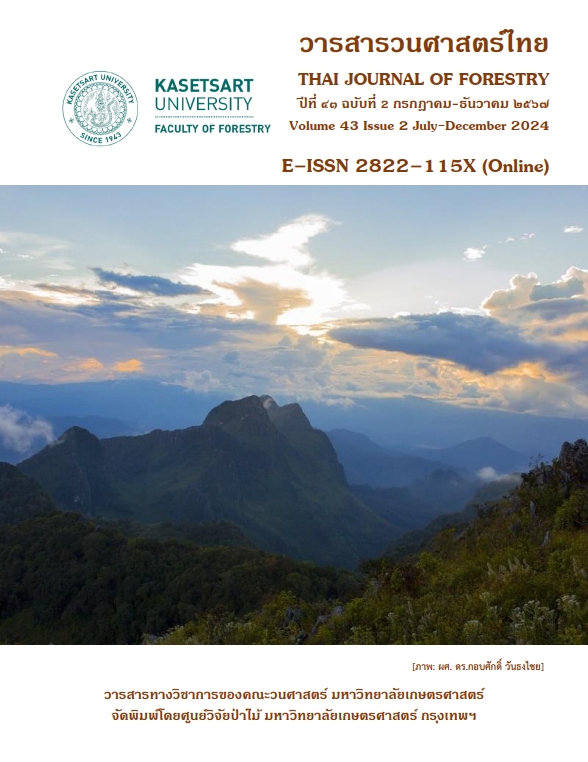A Simulated Comparisons of Thinning Effects Using SIBYLA Program
Main Article Content
บทคัดย่อ
Thinning effects comparisons were undertaken based on two selective thinning options-thinning from below (TB) and thinning from above (TA)-and no thinning (NT). Growth and tree characteristics were investigated using the SIBYLA growth simulation program (originally designed for Czech forests) that was adapted to simulate the growth characteristics of tree species available in Thailand. Specifically, Carpinus viminea (Betulaceae) was chosen as a representative Thai species. The study investigated the effects of TB, TA, and NT on tree productivity (mean height, mean diameter, volume per stem, volume per hectare), biomass, and biodiversity. Pairwise comparisons and statistical analysis were applied. Based on the results, TB could increase the growth potential of trees after thinning more than TA and NT. Although there were similar results for TB and TA in each period, the TB data were slightly higher. However, TA and TB were not significantly different in productivity yields (p>0.05). Therefore, both TA and TB would be effective in increase production yields.
Based on the study, selective thinning model of growth using the SIBYLA program substantially reduced the computational and practical workload. This opens possibilities for further exploration of thinning algorithms and their integration into the SIBYLA program, for application in forestry simulations or the management of Thailand’s diverse plantation forests.
Downloads
Article Details

อนุญาตภายใต้เงื่อนไข Creative Commons Attribution-NonCommercial-NoDerivatives 4.0 International License.
ข้าพเจ้าและผู้เขียนร่วม (ถ้ามี) ขอรับรองว่า ต้นฉบับที่เสนอมานี้ยังไม่เคยได้รับการตีพิมพ์และไม่ได้อยู่ในระหว่างกระบวนการพิจารณาตีพิมพ์ลงในวารสารหรือสิ่งตีพิมพ์อื่นใด ข้าพเจ้าและผู้เขียนร่วม (ถ้ามี) ยอมรับหลักเกณฑ์และเงื่อนไขการพิจารณาต้นฉบับ ทั้งยินยอมให้กองบรรณาธิการมีสิทธิ์พิจารณาและตรวจแก้ต้นฉบับได้ตามที่เห็นสมควร พร้อมนี้ขอมอบลิขสิทธิ์ผลงานที่ได้รับการตีพิมพ์ให้แก่วารสารวนศาสตร์ คณะวนศาสตร์ มหาวิทยาลัยเกษตรศาสตร์ กรณีมีการฟ้องร้องเรื่องการละเมิดลิขสิทธิ์เกี่ยวกับภาพ กราฟ ข้อความส่วนใดส่วนหนึ่ง หรือ ข้อคิดเห็นที่ปรากฏในผลงาน ให้เป็นความรับผิดชอบของข้าพเจ้าและผู้เขียนร่วม (ถ้ามี) แต่เพียงฝ่ายเดียว และหากข้าพเจ้าและผู้เขียนร่วม (ถ้ามี) ประสงค์ถอนบทความในระหว่างกระบวนการพิจารณาของทางวารสาร ข้าพเจ้าและผู้เขียนร่วม (ถ้ามี) ยินดีรับผิดชอบค่าใช้จ่ายทั้งหมดที่เกิดขึ้นในกระบวนการพิจารณาบทความนั้น”
เอกสารอ้างอิง
De Langhe, J. 2013. Carpinus L. Ostrya Scop. Ostryopsis Decne.-Vegetative Key to Species cultivated in Western Europe, 45: 26-46. Ghent University Botanical Garden, Belgium.
Dirr, M.A. 2009. Manual of Woody Landscape Plants, 6th eds, Stipes Publishing LLC, Champaign, Illinois, USA.
Ekholm, A., Lundqvist, L., Axelsson E.P., Egnell, G., Hjalten, J., Lundmark, T., Sjogren, J. 2023. Long-term yield and biodiversity in stands managed with the selection system and the rotation forestry system: A qualitative review. Forest Ecology and Management, 537: 120920. doi.org/10.1016/j.foreco.2023.120920.
Fabrika, M. 2002. Growth Simulator SIBYLA. https://etools.tuzvo.sk/sibyla/english/, 03 October 2023.
Fabrika, M. 2003. Virtual forest stand as a component of sophisticated forestry. Journal of Forest Science, 49: 419-428.
Fabrika, M., Dursky, J. 2005. Algorithms and software solution of thinning models for SIBYLA growth simulator. Journal of Forest Science, 51(10): 431-445. doi: 10.17221/4577-JFS.
Jaehne, S. and Dohrenbusch, A. 1997. A method to evaluate forest stand diversity. European Journal of Forest Research, 333-345.
Kerr, G., Haufe, J. 2011. Thinning Practice a Silvicultural Guide. Forestry Commission, United Kingdom.
Mcdowell, N., Brooks, J.R., Fitzgerald, S.A., Bond, B.J. 2003. Carbon isotope discrimination and growth response of old Pinus ponderosa trees to stand density reductions. Plant, Cell & Environment, 26 (4): 631-644.
Novosadova, K., Kadlec, J., Sykora, P., Komanek, M., Radek, P. 2024. Evaluation of the effect
of different thinning types on dendrometric parameters and subsequent spontaneous growth in a beech-oak-linden stand. Journal of Forest Science, 70(6): 299-316. doi: 10.17221/10/2024-JFS
Simon, DC., Ameztegui, A. 2023. Modelling the influence of thinning intensity and frequency on the future provision of ecosystem services in Mediterranean mountain pine forests. European Journal of Forest Research, 142: 521-535. doi.org/10.1007/s10342-023-01539-y
Thiangburanatham, W. 1999. Thai Herbal Dictionary, 5th ed. Ruamsarn. Bangkok, Thailand. (in Thai)
Zanchi, G., Belyazid, S., Akselsson, C., Yu, L. 2014. Modelling the effects of management intensification on multiple forest services: a Swedish case study. Ecological Modelling, 284: 48-59. doi.org /10.1016/j.ecolmodel.2014.04.006.
Zhao, Z., Zhang, G., Liu, W., Hui, G., Hu, Y. 2022. A novel method for calculating stand structural diversity based on relationship of adjacent trees. Forests, 13(2): 343. doi.org/10.3390/f13020343


